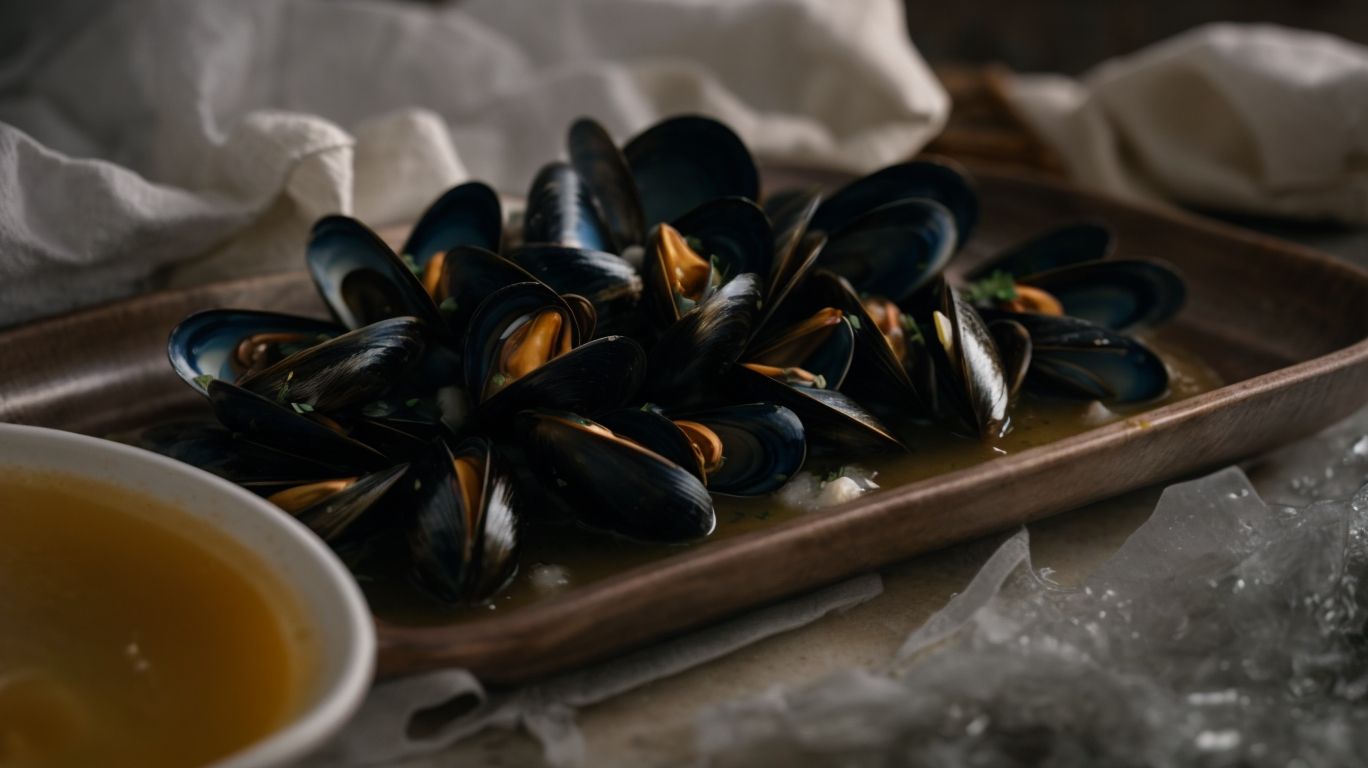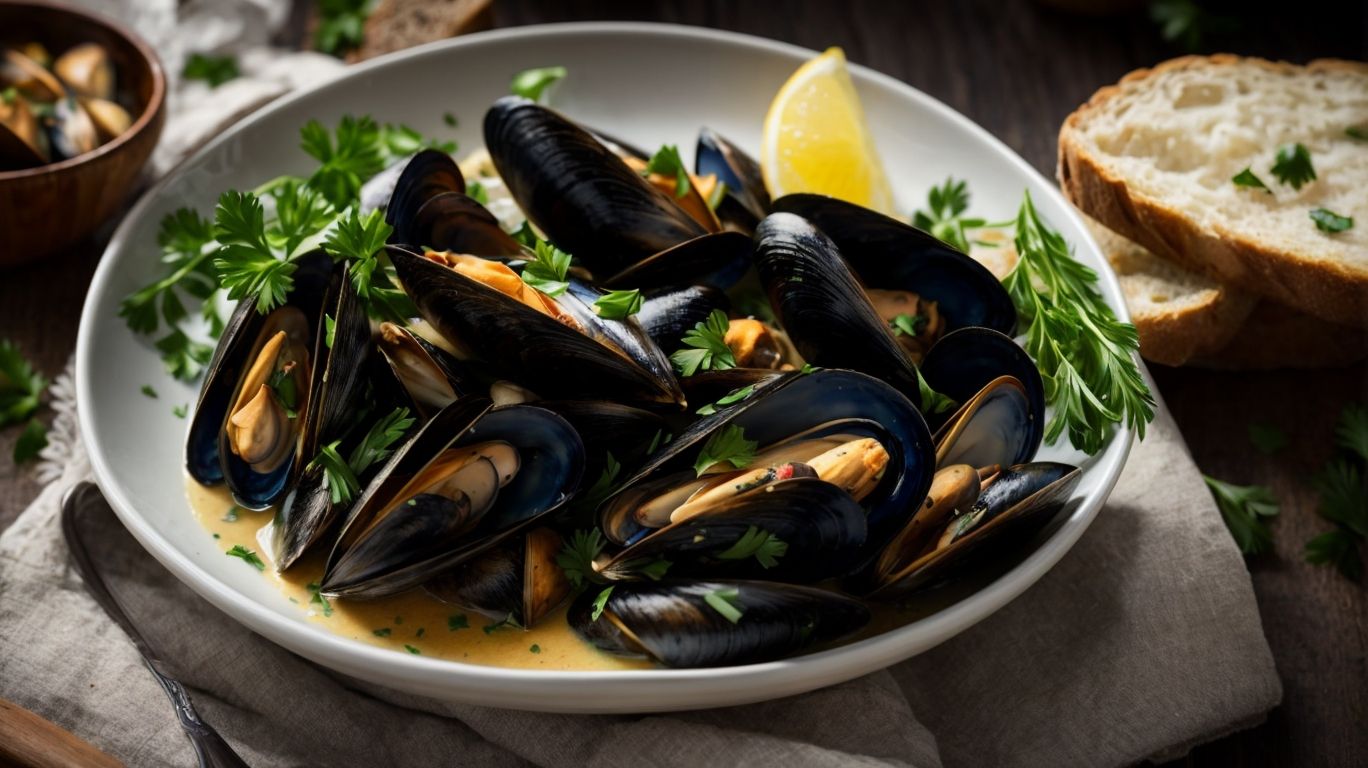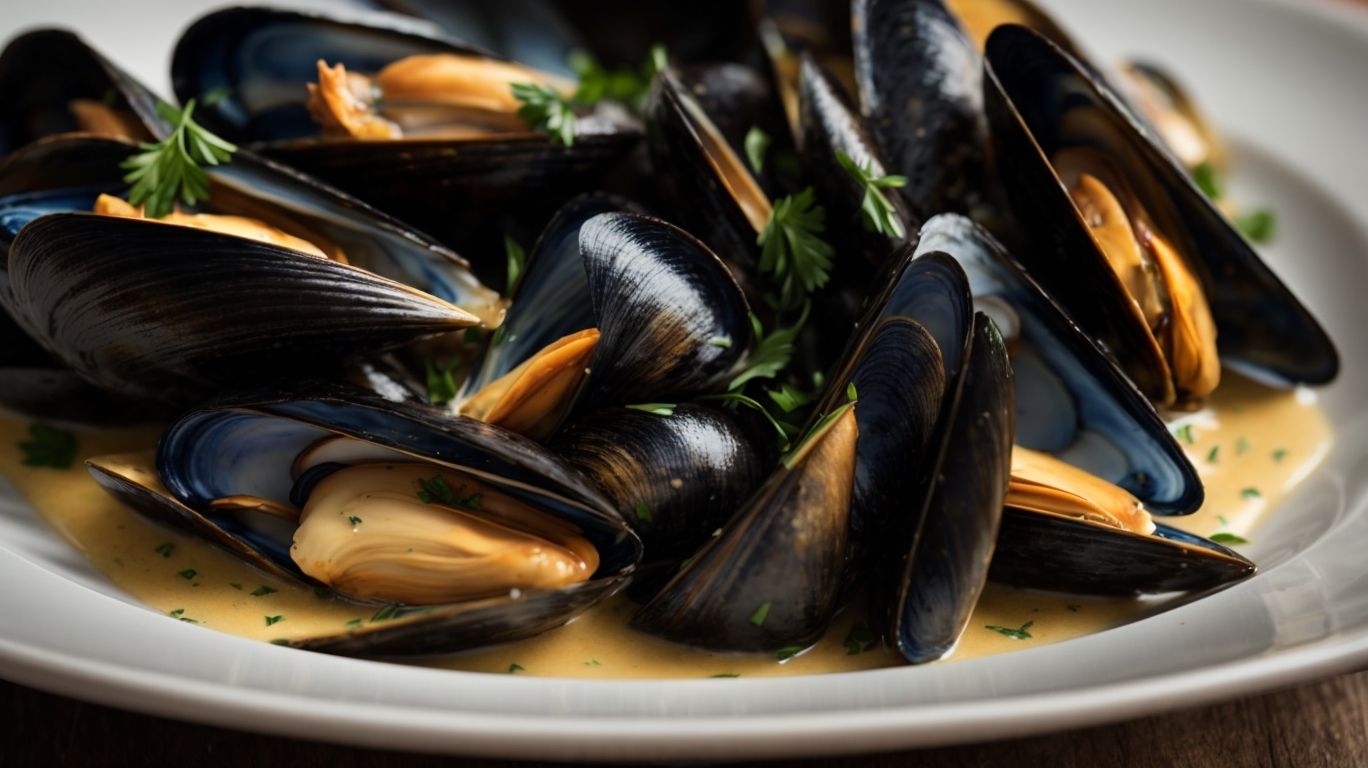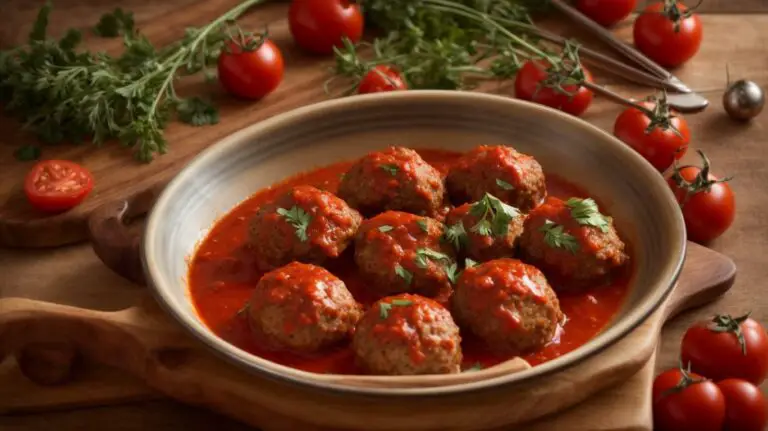How to Cook Mussels With White Wine?
Looking to impress your guests with a delicious seafood dish?
Cook mussels with white wine! We explore why white wine is the perfect companion for mussels, how to select and clean mussels properly, and a step-by-step guide to cooking them perfectly.
Get tips and tricks for perfectly cooked mussels and pairing suggestions to elevate your dining experience. Join us on a culinary journey that will tantalize your taste buds!
Key Takeaways:
Why Use White Wine in Cooking Mussels?
White wine is a crucial ingredient in cooking mussels as it enhances the flavors and adds a depth of complexity to seafood recipes.
When simmered with mussels, white wine not only lends a delicate acidity but also imparts a subtle sweetness that perfectly balances the brininess of the seafood. This infusion of flavors creates a rich broth that is irresistible for dipping crusty bread into. A classic example is the French dish Moules Marinières, where mussels are steamed in a fragrant broth of white wine, garlic, shallots, and parsley, resulting in a delectable and aromatic dish. The use of white wine in mussel recipes dates back centuries and remains a staple in kitchens around the world.
What Type of White Wine Should You Use?
When cooking mussels, it is recommended to use a crisp and flavorful white wine such as Sauvignon Blanc, which pairs exceptionally well with Mediterranean-style seafood dishes.
Sauvignon Blanc is renowned for its bright acidity, citrus notes, and herbaceous tones, making it a versatile option in the kitchen.
The acidity of Sauvignon Blanc helps to cut through the richness of the mussels, while its herbaceous flavors add an extra layer of complexity to the dish.
The citrus undertones of the wine provide a refreshing contrast to the brininess of the seafood, creating a harmonious balance of flavors.
For those who prefer a different flavor profile, alternatives like Chardonnay or Pinot Grigio can also work well with mussels, offering a creamier texture or a lighter, fruit-forward taste.
How to Select and Clean Mussels

Credits: Poormet.Com – Albert Nelson
Selecting and cleaning mussels is a crucial step in preparing a delicious seafood dish, requiring proper cleaning techniques with garlic-infused olive oil for added flavor.
When choosing mussels, look for ones that are tightly closed or those that close when you tap them, as this indicates they are still alive. Avoid mussels that are already open before cooking, as they may be dead and unsafe to consume.
To clean them effectively, start by scrubbing the shells under cold running water to remove any debris. Then, soak them in a bowl of cold water for about 20 minutes to allow them to expel any sand or grit. Next, sauté minced garlic in a pan with olive oil until fragrant, then add the cleaned mussels and cook until they open up, absorbing the delicious flavors. Once cooked, discard any mussels that have not opened as they may be unfit for consumption.
What to Look for When Buying Mussels?
When purchasing mussels, look for ones that are plump, free from cracks, and have a fresh aroma, ensuring they will enhance the savory broth and shallot flavors in your dish.
Another crucial aspect to consider is the size of the mussels. Opt for medium-sized mussels as they tend to be more tender and flavorful. Ensure that the shells are tightly closed or close when tapped, indicating freshness.
Inspect the color of the mussels as well; a vibrant dark color indicates they are healthy and full of nutrients. Avoid any mussels that look dull or have an off smell, as they may be past their prime.
Remember, the quality of your mussels sets the foundation for a delicious seafood meal, so take your time to select the best ones available.
How to Clean and Debeard Mussels?
Cleaning and debearding mussels involves scrubbing the shells, removing the beards, and using a buttered bread slice to soak up excess debris, ensuring a clean and delectable outcome.
Prepare a large bowl of cold water to help purge the mussels of any sand or grit they may contain. As you scrub the shells with a stiff brush under running water, be sure to remove any barnacles or seaweed that may be present. Next, grasp the tough ‘beard’ protruding from the shell and firmly pull it downward to detach it completely. To aid in this process, press a buttered bread slice against the shell to catch any loosened particles, making for efficient cleaning and preventing debris from breaking off into the mussel’s crevices.
Preparing the Ingredients for Cooking
Gathering and preparing the ingredients for cooking mussels requires fresh garlic, fragrant Italian seasoning, and a hint of red pepper flakes to infuse the dish with robust flavors.
For the garlic, finely mince it to release its pungent aroma when sautéed in olive oil. The Italian seasoning, a blend of oregano, basil, thyme, and rosemary, adds depth and complexity to the broth. A touch of red pepper flakes brings a subtle heat that balances the dish’s overall profile.
To enhance the flavors further, consider adding a splash of white wine or broth for a delicate richness. A squeeze of fresh lemon juice just before serving brightens the flavors and adds a refreshing zing.
What Other Ingredients Do You Need?
Plus mussels, essential ingredients for cooking include chicken broth for depth, fresh lemon for a citrusy zing, and crusty bread for sopping up the flavorful juices of the dish.
Chicken broth plays a crucial role in enhancing the overall complexity of the mussels dish. The rich, savory flavor of the broth infuses into the mussels, adding a depth of taste that elevates the entire meal. It provides a perfect base for the flavors to meld together and creates a harmonious balance on the palate.
Adding a splash of fresh lemon juice brightens up the dish, imparting a refreshing and tangy note that cuts through the richness of the broth and mussels. The citrusy zing not only adds a pop of flavor but also offers a burst of freshness that heightens the overall dining experience.
The importance of crusty bread cannot be overstated. Served alongside the mussels, the crusty bread acts as the perfect accompaniment for soaking up the delectable broth and juices. Its crunchy exterior and soft interior provide a textural contrast that complements the tender mussels and adds another layer of enjoyment to the meal.
What Tools Do You Need?
Preparing mussels efficiently requires tools such as a sturdy pot for cooking, a reliable source of olive oil, and a selection of seafood-specific spices to amplify the dish’s Mediterranean-inspired flavors.
In terms of selecting the right pot for cooking mussels, opt for a sizeable one that can accommodate the mussels without overcrowding, allowing them to cook evenly. The pot should have a tight-fitting lid to trap steam and flavors. As for the olive oil, choose a high-quality, extra virgin variety to provide richness and depth to the dish. A drizzle of olive oil not only enhances the flavor but also helps in cooking the mussels to perfection.
In terms of spices, consider adding a mix of fresh herbs such as parsley and thyme, along with a touch of heat from red pepper flakes and a hint of sweetness from a sprinkle of paprika. These spices not only complement the natural brininess of the mussels but also add layers of complexity to the dish.
Step-by-Step Guide to Cooking Mussels with White Wine
Cooking mussels with white wine involves a flavorful process of sautéing garlic, adding broth, and simmering the mussels to perfection, resulting in a delightful seafood dish that captures the essence of Mediterranean cuisine.
Begin by heating olive oil in a large pot over medium heat before adding thinly sliced garlic, sautéing until fragrant. The key here lies in achieving a golden hue without burning the garlic, as it provides the aromatic base for the mussels.
Next, pour in a generous amount of white wine and chicken or vegetable broth, allowing the mixture to come to a gentle simmer.
Gently nestle the fresh mussels into the flavorful broth, ensuring they are well coated. The critical step now is covering the pot, allowing the mussels to steam until they open – a clear indicator of their readiness.
Step 1: Sautéing the Aromatics
To begin the cooking process, sauté minced garlic in olive oil with a medley of aromatic spices, infusing the base of the dish with rich flavors that will permeate the mussels during cooking.
This aromatic step sets the stage for a tantalizing flavor profile in the mussels dish. The sizzle of garlic in fragrant olive oil creates a mouthwatering aroma that fills the kitchen. Carefully selecting a blend of spices such as paprika, cayenne, and thyme can enhance the natural sweetness of the mussels while adding a subtle kick.
Combining these spices allows for a harmonious balance of flavors; the earthy notes of thyme complement the smokiness of paprika, while a hint of cayenne adds a gentle heat that lingers on the palate.
Step 2: Adding the Mussels and White Wine
Next, add the cleaned mussels to the pot, pour in the white wine and broth mixture, and sprinkle shallots over the top, allowing the flavors to meld and the mussels to cook gently in the aromatic liquid.
As the mussels simmer in the pot, the gentle heat allows them to slowly open, releasing their briny goodness into the broth. This slow cooking process is crucial as it ensures that the mussels remain tender and absorb the flavors of the wine and shallots without becoming tough. The steam created within the pot helps infuse each mussel with the essence of the ingredients, resulting in a harmonious blend of flavors that will tantalize your taste buds.
Step 3: Simmering and Serving the Mussels
Allow the mussels to simmer in the flavorful broth until they open, squeeze fresh lemon juice over the dish for a burst of citrusy freshness, and serve the mussels with crusty bread to soak up the delicious broth.
When simmering mussels, it is crucial to avoid overcooking them as this can lead to a rubbery texture, so watch closely for their shells to open. The addition of lemon juice not only enhances the flavors but also adds a tangy zing that complements the brininess of the mussels.
When presenting the dish, make sure to arrange the mussels attractively in a bowl or plate, drizzling some of the broth on top for extra flavor. The crusty bread serves as the perfect accompaniment to soak up the broth and savor every last bit of the delicious liquid.
Tips and Tricks for Perfectly Cooked Mussels
Achieving perfectly cooked mussels requires attention to detail, from selecting fresh ingredients to infusing the dish with the right balance of flavors, such as the aromatic essence of garlic cloves.
When preparing mussels, ensure you start by cleaning them thoroughly to rid them of any sand or debris. Soaking them in cold water with a bit of salt for about 20 minutes can help in this process. For added depth of flavor, consider incorporating white wine or broth during the cooking process. This not only tenderizes the mussels but also imparts a delightful complexity to the dish.
Pairing Suggestions for Mussels with White Wine

Credits: Poormet.Com – Nathan Taylor
Pairing mussels with white wine opens up a world of culinary possibilities, from refreshing side salads to hearty main meals that complement the seafood flavors and elevate the dining experience.
For a light and fresh option, serve the mussels with a citrusy arugula and grapefruit salad dressed in a zesty vinaigrette. The vibrant acidity of the salad will harmonize with the subtle sweetness of the mussels, creating a delightful contrast on the palate.
If you prefer a more substantial pairing, consider preparing a classic moules marinière with crusty bread for dipping into the flavorful broth. The combination of tender mussels simmered in a fragrant white wine sauce alongside crusty bread is a quintessential French delight.
In terms of main courses, a roasted branzino with lemon and herbs makes an excellent companion to mussels cooked in white wine. The delicate flavors of the fish complement the briny notes of the mussels, offering a balanced and satisfying meal.
- For a vegetarian-friendly option, pair the mussels with a creamy risotto infused with saffron and topped with freshly grated parmesan. The rich and creamy texture of the risotto provides a luxurious backdrop for the tender mussels.
- Alternatively, a seafood paella loaded with shrimp, clams, and chorizo alongside the mussels creates a festive and flavorful feast that is perfect for sharing with a group of friends or family.
When selecting a wine to accompany mussels cooked with white wine, opt for a crisp and mineral-driven Chablis or a lively Sauvignon Blanc from New Zealand. Both wines have the acidity and brightness to enhance the flavors of the dish without overpowering the delicate nuances of the mussels.
What Type of Wine to Serve with Mussels?
When serving mussels, consider pairing them with a crisp Sauvignon Blanc that complements the dish’s flavors, enhancing the seafood experience with its vibrant and citrusy notes.
Sauvignon Blanc is renowned for its high acidity and herbaceous undertones, making it an ideal match for the briny sweetness of mussels. The wine’s zesty character cuts through the richness of the shellfish, cleansing the palate between bites.
The Sauvignon Blanc’s citrus flavors, such as grapefruit and lemon, add a refreshing contrast to the savory elements of the mussels, elevating the overall taste profile of the dish.
What Side Dishes Complement Mussels?
Complementing mussels with a fresh side salad featuring Mediterranean-style ingredients like lemon-infused dressing adds a refreshing contrast to the savory seafood flavors, creating a balanced and satisfying meal.
If you are looking for additional accompaniments that complement the delicate taste of mussels, consider serving them with a side of grilled asparagus drizzled with olive oil and sprinkled with a hint of lemon zest. The charred smokiness of the asparagus paired with the citrus undertones provides a harmonious blend with the briny sweetness of the mussels.
Alternatively, a quinoa salad mixed with diced cucumbers, cherry tomatoes, feta cheese, and a squeeze of fresh lime juice can offer a light and nutritious option to pair with the mussels. The combination of textures and flavors enhances the dining experience, infusing a burst of Mediterranean-inspired elements.
Conclusion and Final Thoughts
Cooking mussels with white wine is a delightful culinary adventure that yields a delicious dish best enjoyed with a side of crusty bread, making it a perfect choice for seafood enthusiasts seeking a flavorful dining experience.
There is something magical about the way the flavors of the mussels, white wine, and aromatic herbs come together in this dish, creating a harmonious symphony of taste and texture.
The process of preparing the mussels, from cleaning and debearding to simmering them in the flavorful broth, is a satisfying and interactive experience that adds to the anticipation of the meal.
Once the mussels are cooked to perfection and served steaming hot, dipping pieces of crusty bread into the savory broth becomes a ritual that elevates the dining experience to a whole new level.
Pairing this seafood delight with a chilled glass of white wine brings out the subtle flavors of the dish and enhances the overall enjoyment of the meal, creating a memorable gastronomic experience that is sure to delight the senses.
Frequently Asked Questions
What ingredients do I need to cook mussels with white wine?
To make this delicious dish, you will need mussels, white wine, butter, garlic, parsley, and crusty bread for serving.
How do I clean mussels before cooking?
Start by scrubbing the mussels with a brush under cold water. Then, remove the beards (fibrous threads) by pulling them towards the hinge of the shell. Discard any mussels that are open or cracked.
Can I use any type of white wine for cooking mussels?
Yes, you can use any dry white wine such as Sauvignon Blanc, Pinot Grigio, or Chardonnay. Avoid using sweet white wines as they can overpower the delicate flavor of the mussels.
How long does it take to cook mussels with white wine?
Mussels cook very quickly and will be ready in about 5-7 minutes. You will know they are done when the shells open up.
Can I add other ingredients to the mussels while cooking?
Absolutely! You can add other seafood such as shrimp or clams, or even vegetables like diced tomatoes or sliced bell peppers to enhance the flavor of the dish.
Do I need to add salt to the dish?
No, you do not need to add salt as the mussels are naturally salty. However, you can add a pinch of salt if desired, depending on your personal taste preference.







